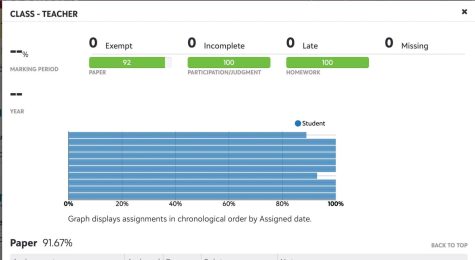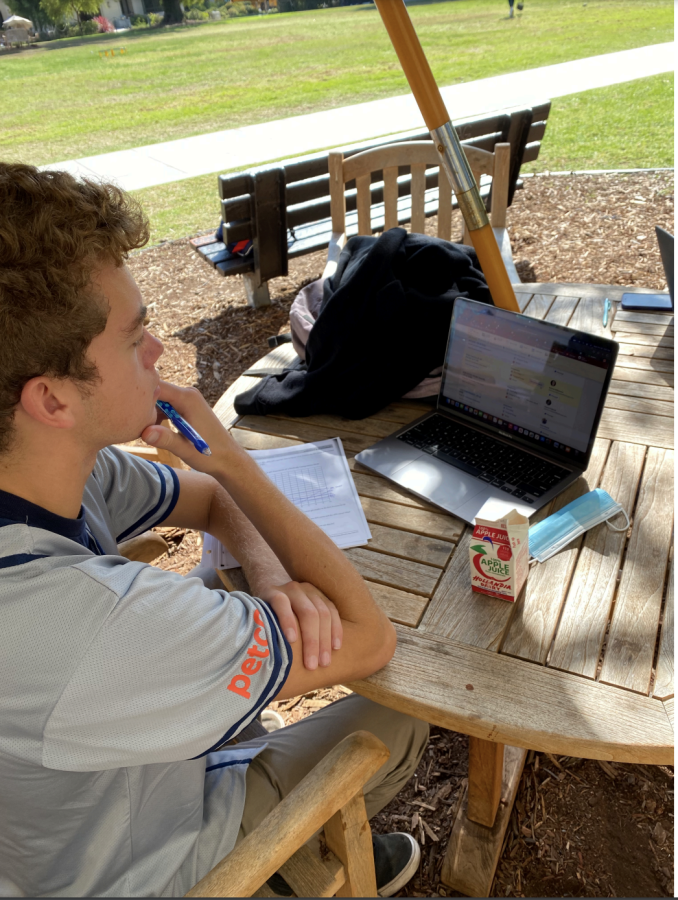Your Current Grade Is…
A look into Bishop’s’ open and closed grade-book policies
Senior Aiden Gutierrez’s Honors Economics class offers an open gradebook, which gives him a better insight into his status in the class.
The question of whether or not we should have an open grade book policy at Bishop’s is a hotly debated and often one-sided opinion amongst students, with most students supporting the push for greater grade transparency. Is it justified to have some classes that include an open grade book online and other classes where you cannot check your grade in the class? The open grading policy investigated here is not to support that having grades available will reduce anxiety or vice versa (supporting the way we have grades currently) because one subjective opinion is not the topic of discussion. My goal is to understand how the faculty came to this decision, notably varying in different departments, and to understand the thought process behind what they deemed best for their students.
There are many other schools out there without an open grade book. You may previously have been under the impression that Bishop’s was alone in rarely giving actively open grade feedback. However, after looking at the top ranked private college preparatory institutions, it is apparent that a linking commonality among many of them is that grades are not displayed in an open website form. An intriguing example of grading at the college level is the policies at Brown and Harvard University that do not provide students with letter grades. Instead, Brown University chose to discontinue its calculation of grade point averages for its students and instead, according to Brown University’s website, “promote the use of criteria for assessment and evaluation that go beyond grades and GPA.” It was interesting to see that Brown’s educational policies shape a student for their, “analytical ability, independence, creativity, communication, and leadership skills, qualities not necessarily reflected in a GPA”. Not only does Brown prioritize this style of learning, but it seems their grading system was structured to minimize the mindset of a typical college student that fixates on receiving a high grade point average above all else, potentially missing out on some of the learning.
Brown also incorporates a different scope for learning by allowing a student to take an unlimited number of S/NC (Satisfactory/No Credit) courses and only recording full-letter grades of A, B, or C. (without plusses and minuses). There is no D grade, and no failed grades are kept. The takeaway here is that perhaps a less fully transparent grade book is not the end of the world, but in fact, a strategic design made by teachers to dissuade their students from becoming completely consumed by a letter grade and instead immerse themselves in the learning experience itself.
However, closer to home, the question persists regarding the issue of students feeling uncertain about their grades when the end of the semester approaches. Some say not having complete grade transparency increases grade anxiety. Seiji Sekiguchi (‘22) explained that in his experience, “students do not have enough idea of what their performance and hard work really equates to in the class which is necessary for many students to feel any level of mastery with the material.” He continued that in his experience with competitive classes such as honors English courses, “The school environment always seems to tense up near the end of quarters and semesters as students are looking to improve their grades before it’s too late; but few seem to know where their grades actually stand. It’s an issue of an already competitive and stressful atmosphere increased by the fear and anxiety of closed grading with no access to seeing what your performance equates to throughout the quarter.”
So, it became clear that there were two clear sides to this debate; both argue that the other increases grading stress. Do students and teachers have the same understanding when it comes to grading stress? This side of the argument presented by Seiji is that grades are intrinsically woven into our lives as the end all be all or at least largely thought of as the main determiner of a Bishop’s student’s successes and so there’s a sort of disconnect without knowing these numbers which increases stress.

The most common example of a department that strictly opts to not share an open gradebook or provide any letter grades is the English department (aside from Ms. Katherine Kelly).“In English, we really grade with an eye towards progress,” English department head Dr. Anna Clark said. “So what a students grade is in the middle of the quarter is not going to be terribly predicted necessarily of what their grade will be at the end because we’re weighting the work that comes at the end much more heavily than what comes earlier typically because we want to give students room to improve.”
This alluded to the idea of a growth mindset which Dr Clark clearly outlines is a main principle driving the development for students in her class. She continued on, detailing the mentality for English classes in that, “the idea of an open gradebook wouldn’t necessarily offer information that would assuage students anxieties and might in fact exacerbate them because it’s not a full picture of the quarter or of the semester.” She articulated her responses carefully and methodically and it was clear that through much deliberation she had given the same speech before. Dr Clark assured me that she was “really sympathetic to the anxiety that grades produce”.. However “leaning into the grade transparency isn’t necessarily the answer to that.” If anything it just seems to center a letter grade in a student’s life even more.”
A student with the predisposed preference towards letter grades going into this conversation might feel persuaded by her point on letter grades producing an obsession to monitor them. She continued saying, “I think we can all think of situations where the ability to monitor something makes us even more inclined to monitor it. I sometimes think that thinking of open grade books as the solution to a problem is really a problem much bigger than that. She said that,, “For a lot of independent schools of Bishop’s caliber, their English departments have the same policies that we do and really push against the idea of open gradebooks and also letter grades on essays. So it is a sort of larger philosophy I think within our discipline that we’re aligned with.” She added that grading methods did change depending on the discipline. “The question of disciplinary difference is a really crucial one for this because what science needs is going to look very different from what English needs.” It’s evident that the English department finds it imperative to continue grading more holistically of the students’ efforts without the need for letter grade feedback. However, Dr Clark did explain that, “It is a department- wide policy that we revisit frequently. We all sit around this table and chat about it.”
“I sometimes think that thinking of open grade books as the solution to a problem is really a problem much bigger than that.”- Dr. Clark
I also had the chance to talk with Senior class President, Hunter Kates (‘22). ASBC president Hunter Kates included greater grade transparency as a central tenet of his platform while running, “Many students favor the open grade book or even just a greater awareness of where they stand in a class, and this year I decided that we should take some baby steps to accomplish more awareness for students that would in turn decrease stress” he said. Hunter informed me that he sat down with the English department heads and said he “proposed that two times a semester English teachers should tell their students where they stand in the class, hopefully initiating conversations that will lead to improvement. Their decision was no, almost immediately. The no for me wasn’t the problem..I respect the teachers decision. But when we have a large portion of students who feel like greater grade transparency would heavily reduce grading stress it leads me to think it would benefit the student body and the school as a whole if teachers more seriously considered student proposals.”
Doc Pelletier discussed with me his grading policies for honors Chemistry and the honors level science courses he offers. He told me, “I keep my Honors Chemistry book open for students to see. For the most part, it reduces the student’s anxiety. But, another main reason is students catch mistakes I make. When I transfer grades, I sometimes make mistakes. Also, students find mistakes when I hand tests back. As I always tell students, nothing pleases me more than finding more points they’ve earned that I missed the first time. But, sometimes I forget to change it in my grade book. They can then remind me of that. Such a case happened just yesterday where a student pointed out an error in my grading and they were able to see a direct change in the gradebook.” Doc shares some insightful thinking here explaining that for his science courses it can be useful for students to see a statistical number for grading through an open gradebook to reduce grade anxiety.
Math courses are conducted similarly. David Johnston, head of the middle school math department explained to me how he grades the middle schoolers in math which takes a markedly different approach to grading in high school. He emphasized a change stating that, “In years past, the main focus was on quizzes and tests. We take a quiz almost every day and all of those quizzes were averaged out to equal one test score. That one “test” score was then averaged out with the other two or three actual tests in a quarter to generate a quarter grade. Homework, notes and class participation all received detailed comments in my progress reports. However, the middle school has recently adopted new grading policies for the 6th and 7th grade that move away from letter grades and, instead, requires us to comment directly on a combination of behaviors: Readiness for class, homework, note-taking, participation, and overall comfort and facility with the material.” Mr Johnston’s approach was to eliminate the concept of letter grades and move to a more holistic evaluation of the students’ efforts. This eliminated all of the negative baggage that letter grades induce which potentially inhibit the learning process for middle school students. Jennifer Seymour, a math teacher in the Upper school commented on her grading policy, informing me, “I have an open gradebook in all my classes. The pros of an open gradebook from a teacher’s perspective are that I know that students can check their grades for accuracy, I can alert them of missing assignments and leave visible comments in real-time, and students know their standing in the class.” Then, she acknowledged the downfalls to her method: “The cons of an open gradebook are that when I publish big grades (assessments/projects) I often get a bunch of knee-jerk worried emails from students immediately after that I then have to deal with (whereas when students see their grades on a paper handed back in class, I can just address all questions/concerns at that time). So, the way students handle having an open gradebook can be frustrating for teachers; I’d recommend that students wait until actually receiving the assessment back in person and then talking with their teacher during class or office hours about specifics.”
Finally, I asked our Head of Upper school, Brian Ogden, to share his knowledge on the school-wide policy regarding grades at Bishop’s. Mr Ogden thoroughly explained that, “we trust department chairs and teachers who are the experts in adolescent learning and their disciplines to make important pedagogical decisions around specific feedback and assessment practices. Our school-wide practice is to report grades at the midterm as a snapshot of where students are at that point and report final grades at the semester. At interim points we provide early feedback, midterm comments, and depending on the individual student, academic updates.” It is important to note here that academic updates are only sent out in the case of students performing poorly.
This begs the question: Where is the feedback sent out for the student whose performance could be anywhere from just alright to brilliant? Mr. Ogden continued, informing me that “Decisions departments and teachers make about open grade books will likely vary based on grade-level and discipline and when possible, based on what we know about adolescent learning. Adolescent learning and development is an ever-evolving discipline and we aim to have what we know be a guide for the practices we adopt school-wide. To that point, not all educators agree on best pedagogical practices and while one practice may be best for one discipline or grade-level, that may not be the case for another.”
Certainly you might not feel that your Math grade being available online for view is different from your English grade, however, after conversations with numerous teachers at Bishop’s we should all be assured that there is supposedly a lot of thought and ongoing discussion behind each discipline’s decision.

Graham Walker is a senior and is new to The Tower’s staff this 2021-2022 school year. He passionately plays basketball and golf for the Bishop’s School....






